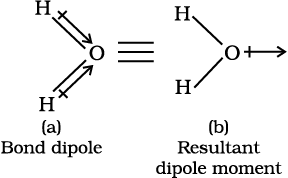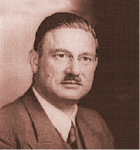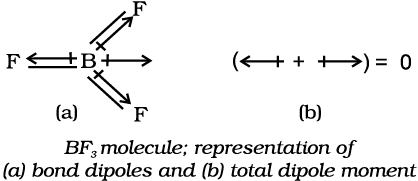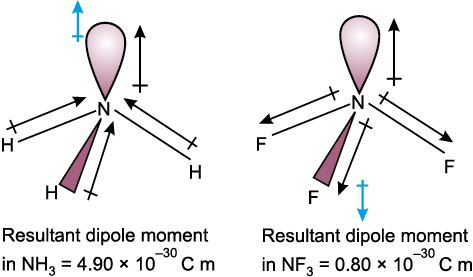The existence of a hundred percent ionic or covalent bond represents an ideal situation. In reality no bond or a compound is either completely covalent or ionic. Even in case of covalent bond between two hydrogen atoms, there is some ionic character.
When covalent bond is formed between two similar atoms, for example in H2, O2, Cl2, N2 or F2, the shared pair of electrons is equally attracted by the two atoms. As a result electron pair is situated exactly between the two identical nuclei. The bond so formed is called nonpolar covalent bond. Contrary to this in case of a heteronuclear molecule like HF, the shared electron pair between the two atoms gets displaced more towards fluorine since the electronegativity of fluorine (Unit 3) is far greater than that of hydrogen. The resultant covalent bond is a polar covalent bond.
As a result of polarisation, the molecule possesses the dipole moment (depicted below) which can be defined as the product of the magnitude of the charge and the distance between the centres of positive and negative charge. It is usually designated by a Greek letter ‘µ’. Mathematically, it is expressed as follows :
Dipole moment (µ) = charge (Q) × distaTable 4.2 Average Bond Lengths for Some Single, Double and Triple Bonds Bond Type Covalent Bond Lengthnce of separation (r)
Dipole moment is usually expressed in Debye units (D). The conversion factor is
1 D = 3.33564 × 10–30 C m
where C is coulomb and m is meter.
Further dipole moment is a vector quantity and by convention it is depicted by a small arrow with tail on the negative centre and head pointing towards the positive centre. But in chemistry presence of dipole moment is represented by the crossed arrow ( ) put on Lewis structure of the molecule. The cross is on positive end and arrow head is on negative end. For example the dipole moment of HF may be represented as :
) put on Lewis structure of the molecule. The cross is on positive end and arrow head is on negative end. For example the dipole moment of HF may be represented as :

This arrow symbolises the direction of the shift of electron density in the molecule. Note that the direction of crossed arrow is opposite to the conventional direction of dipole moment vector.
In case of polyatomic molecules the dipole moment not only depend upon the individual dipole moments of bonds known as bond dipoles but also on the spatial arrangement of various bonds in the molecule. In such case, the dipole moment of a molecule is the vector sum of the dipole moments of various bonds. For example in H2O molecule, which has a bent structure, the two O–H bonds are oriented at an angle of 104.50. Net dipole moment of 6.17 × 10–30 C m (1D = 3.33564 × 10–30 C m) is the resultant of the dipole moments of two O–H bonds.


Peter Debye, the Dutch chemist received Nobel prize in 1936 for his work on X-ray diffraction and dipole moments. The magnitude of the dipole moment is given in Debye units in order to honour him.
Net Dipole moment, µ = 1.85 D = 1.85 × 3.33564 × 10–30 C m = 6.17 ×10–30 C m
The dipole moment in case of BeF2 is zero. This is because the two equal bond dipoles point in opposite directions and cancel the effect of each other.

In tetra-atomic molecule, for example in BF3, the dipole moment is zero although the B – F bonds are oriented at an angle of 120o to one another, the three bond moments give a net sum of zero as the resultant of any two is equal and opposite to the third.

Let us study an interesting case of NH3 and NF3 molecule. Both the molecules have pyramidal shape with a lone pair of electrons on nitrogen atom. Although fluorine is more electronegative than nitrogen, the resultant dipole moment of NH3 ( 4.90 × 10–30 C m) is greater than that of NF3 (0.8 × 10–30 C m). This is because, in case of NH3 the orbital dipole due to lone pair is in the same direction as the resultant dipole moment of the N – H bonds, whereas in NF3 the orbital dipole is in the direction opposite to the resultant dipole moment of the three N–F bonds. The orbital dipole because of lone pair decreases the effect of the resultant N – F bond moments, which results in the low dipole moment of NF3 as represented below :

Dipole moments of some molecules are shown in Table 4.5.
Just as all the covalent bonds have some partial ionic character, the ionic bonds also have partial covalent character. The partial covalent character of ionic bonds was discussed by Fajans
in terms of the following rules:
• The smaller the size of the cation and the larger the size of the anion, the greater the covalent character of an ionic bond.
• The greater the charge on the cation, the greater the covalent character of the ionic bond.
• For cations of the same size and charge, the one, with electronic configuration
(n-1)dnnso, typical of transition metals, is more polarising than the one with a noble gas configuration, ns2 np6, typical of alkali and alkaline earth metal cations.
The cation polarises the anion, pulling the electronic charge toward itself and thereby increasing the electronic charge between the two. This is precisely what happens in a covalent bond, i.e., buildup of electron charge density between the nuclei. The polarising power of the cation, the polarisability of the anion and the extent of distortion (polarisation) of anion are the factors, which determine the per cent covalent character of the ionic bond.